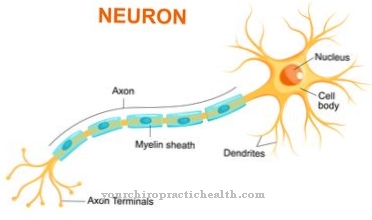The Osteomyelofibrosis is a very rare, chronic and incurable disease of the bone marrow. It is associated with an increasing restriction in blood cell formation, which leads to various complications such as anemia, bleeding and an increased risk of infection.
What is osteomyelofibrosis?

© freshidea - stock.adobe.com
The Osteomyelofibrosis (also chronic idiopathic myelofibrosis, Osteomyelosclerosis or primary myelofibrosis) belongs to the so-called chronic myleoproliferative diseases. These are characterized by an overproduction of blood cells by the blood-forming cells in the bone marrow, the so-called hematopoietic stem cells.
In osteomyelofibrosis, leukocytes and thrombocytes in particular are increased in the early phase of the disease. As the disease progresses, increasingly fibrous connective tissue is formed in the bone marrow, which in the long term causes the blood-forming bone marrow tissue to become obliterated. Blood formation is shifted to the spleen and liver, which are therefore significantly enlarged.
As these cannot completely compensate for normal blood formation in the bone marrow, pronounced anemia (anemia) develops. Osteomyelofibrosis is a very rare disease with an incidence of 0.6 to 1.5 per 100,000 population or 1200 new cases annually. Women are affected more often than men. The mean age of onset is between 60 and 65 years.
causes
The causes and etiology of osteomyelofibrosis have not yet been clarified. The disease occurs as a primary or idiopathic form independently or as a secondary result of another disease that changes the bone marrow. In primary osteomyelofibrosis, an acquired genetic defect is assumed.
In 50 percent of cases, a mutation typical of chronic myeloproliferative diseases - the so-called JAK2 mutation - can be detected. In addition, factors such as exposure to ionizing radiation or chemical substances as well as other, so far unexplained influencing factors are discussed as possible causes.
Underlying diseases of the secondary form are in particular essential thrombocythemia (greatly increased increase in blood platelets) and polycythemia vera (greatly increased formation of red blood cells).
Symptoms, ailments & signs
Osteomyelofibrosis is characterized by a gradual onset and slow development of symptoms. Clinically, the disease expresses itself on the basis of the characteristic triad of high-grade abnormal connective tissue proliferation (marrow fibrosis) with obliteration of the blood-forming bone marrow tissue, displaced blood formation in the spleen and liver (extramedullary hematopoiesis) and enlargement of the spleen (splenomegaly) as a result of the displaced blood formation.
As a result of the greatly enlarged spleen, adjacent organs, especially intestinal areas, are also displaced. The bowel movement (peristalsis) is hindered. There are different, sometimes changing symptoms such as a feeling of pressure in the left upper abdomen, increasing abdominal girth and heartburn. The increase in pressure in the abdomen leads to fractures (hernias of the groin, navel or stomach) and pressure on the bile duct and blood vessels.
The excessively enlarged spleen also filters too many blood cells from the peripheral blood (hypersplenism). Since the spleen and liver cannot completely replace the bone marrow, blood cell formation is limited in the further course. Both processes lead to a sharp decrease in all blood cells (pancytopenia) as well as increased bleeding tendency and susceptibility to infection. In some cases, the liver is also slightly enlarged. General symptoms are often loss of appetite with weight loss, reduced performance and occasional fever and night sweats.
Diagnosis & course of disease
The diagnosis is often made by chance due to the enlarged and therefore painful spleen or as part of a routine blood test. In the early phase, the blood count shows a greatly increased number of white blood cells (leukocytosis) and increased platelet formation (thrombocytosis), while the red blood cells (erythrocytes) are mostly normal.
In the late phase, pancytopenia, in which blood formation decreases in all three cell rows, can be detected in the blood count. In addition, immature precursors of white and red blood cells appear in the blood smear as a result of the extramedullary blood formation (so-called leukoerythroblastic blood count). In addition, the characteristic JAK2 mutation can be detected.
Diagnostically decisive is the bone marrow puncture, with which no or very little bone marrow is obtained (so-called punctio sicca or "dry marrow"). The subsequent tissue examination shows the marrow fibrosis. Sonography can assess the enlargement of the spleen and liver.
The x-ray may show the excessive accumulation of calcareous bone substance (sclerosis) in the spine area. The course and prognosis of the incurable disease are very variable and must be assessed individually. The prognosis of the primary form is better than that of the secondary. Overall, the survival time averages five years.
Complications
Osteomyelofibrosis is a malignant disease of the blood-forming system. However, their prognosis is very different. Death can occur at any stage of the disease due to serious complications. However, a significant reduction in the risk of complications is possible as part of the therapy. In the early phase of the disease, thromboses often develop, which can lead to embolisms with fatal consequences.
This is caused by a very high rate of division of the blood-forming cells. Later, a sharp decrease in the number of different blood cells dominates, which is known as pancytopenia. Blood formation then no longer takes place in the bone marrow, but in the spleen and liver. For this reason, splenomegaly and hepatomegaly occur in the late phase of osteomyelofibrosis. So the spleen and liver enlarge very much.
As a complication of splenomegaly, hypersplenism with constant anemia, increased bleeding tendency and an increased risk of infections occurs. In addition, hypersplenism is very painful because the size of the spleen can displace neighboring organs. If left untreated, this condition is sometimes fatal. Furthermore, a so-called blast surge can occur in the late stage.
This leads to an aggressive leukemia with a fatal outcome due to the increased formation of immature myolytic and lymphatic blood cells. In addition to leukemia, infections are the most common fatal complications of osteomyelofibrosis.
When should you go to the doctor?
People who have a general feeling of illness with an increasing tendency should consult a doctor. If there is swelling in the area of the upper body, increasing abdominal girth or heartburn, a doctor is required to clarify the symptoms. A decrease in performance, fever, internal weakness and loss of appetite are signs of a health disorder. A doctor's visit is necessary if there is a feeling of pressure or a fracture in the area of the navel or stomach.
Intestinal discomfort or repeated noise in the gastrointestinal area are considered unusual. A doctor should be consulted so that research into the cause can be initiated. Osteomyelofibrosis is characterized by a slow increase in symptoms and a simultaneous decrease in quality of life. The process is described by patients as creeping and takes place over several months. If the daily obligations can no longer be fulfilled, participation in social and societal life decreases and well-being decreases, a doctor must be informed of the developments.
Nocturnal sweats, changes in the connective tissue, irregularities in the heart rhythm and circulatory disorders should be presented to a doctor. If thrombosis develops, the person concerned is at risk. Medical care as quickly as possible is necessary so that there is no permanent damage to health or premature death.
Treatment & Therapy
A causal therapy is not possible in osteomyelofibrosis. Since the blood-forming bone marrow is increasingly being destroyed, only an allogeneic blood stem cell transplant can cure the disease in the long term. However, the high-risk transplantation is only carried out in under 60-year-olds who have no significant comorbidities.
The chances of success are also lower, as the transplanted blood stem cells do not settle well in the sclerosed bone marrow. In addition, treatment is only given symptomatically. In the early phase, alpha interferon or hydroxyurea are used to reduce the platelet and leukocyte count with medication.
With the help of thalidomide and lenalidomide - possibly in combination with predisolone - the need for transfusions caused by the anemia is reduced. If the erythrocyte and platelet counts are too low, red or white blood cell concentrates can be added in the late phase (erythrocyte or platelet substitution). The erythrocyte concentrates supply the body with high amounts of iron.
This accumulates in the body and can damage the heart and liver (secondary hemochromatosis). The excess iron can be expelled through special medication. In order to stimulate the formation of red blood cells, growth factors such as erythropoietin or, in very rare cases, androgens such as winobanin or metenol are also used.
If there is an increased risk of thrombosis due to thrombocytosis, ASA (100 / dl) or anagrelide as a reserve drug is used. A splenectomy (removal of the spleen) is usually carried out in the early stages and only in the case of mechanical displacement symptoms and hypersplenism, since replacement blood formation takes place in the spleen. In the late stages, a mild form of radiation to reduce the size of the spleen may be indicated.
You can find your medication here
➔ Medicines for painOutlook & forecast
The prognosis of osteomyelofibrosis depends on numerous factors because it varies widely. This includes whether it is a primary or secondary disease, or whether the patent has additional diseases.
With primary osteomyelofibrosis, a reduced life expectancy must be expected. Around 50 percent of all affected people are expected to live another five years. Life expectancy is more than ten years for 20 percent of all patients. However, the rare disease is primarily seen in older people. The most common causes of death in the context of osteomyelofibrosis include cardiovascular failure and infections due to bone marrow weakness. Sometimes aggressive acute myeloid leukemia also occurs. However, the prognosis also depends on the genetic defect underlying the disease. Leukocytosis, leukopenia, neoangiogenesis, thrombocytopenia and severe anemia (anemia) are considered unfavorable factors for the prognosis.
Due to the different prognoses, there is a special risk score. This differentiates between four patient risk groups. The assessment also has an impact on the therapeutic measures. Age over 65 and symptoms such as weight loss, night sweats and fever are considered negative factors for the prognosis.
A permanent cure for osteomyelofibrosis is only possible with an allogeneic bone marrow transplant. However, because of its high risks, it is only performed on patients under 50 years of age.
prevention
Osteomyelofibrosis cannot be prevented.
Aftercare
In most cases of osteomyelofibrosis, those affected have only very few and usually only limited direct follow-up measures available. For this reason, those affected with this disease should consult a doctor very early on so that there are no complications or other complaints in the further course. The earlier a doctor is consulted, the better the further course of the disease will usually be.
Those affected themselves are mostly dependent on taking various medications. Care should always be taken to ensure the correct dosage and regular intake in order to relieve the symptoms correctly and permanently. Regular checks by a doctor are also very useful and can prevent further damage.
Most patients depend on the help and support of their own families in their everyday lives. Psychological support also has a positive effect on the further course of osteomyelofibrosis and can prevent the development of depression and other psychological complaints. The disease may also lead to a reduced life expectancy for the person affected, whereby the further course depends very much on the time of diagnosis.
You can do that yourself
In addition to medical treatment, a positive attitude has a positive effect on the further course of the disease. Conversations with a therapist are often useful support, as mindfulness and calm are conveyed in many life situations.
In order to be able to effectively adapt the therapy at the doctor to your own needs, it is advisable to note down symptoms such as pain, itching, tiredness, weight loss etc. every week and to show the notes at the next doctor's appointment.
Physical activity adapted to your own performance helps to reduce stress, strengthens the body and improves general well-being. Travel can also have this effect, but those affected must always make sure to pack meaningful medical documents so that doctors on site can quickly read the case if necessary. In addition, the necessary vaccinations must be carried out in good time in order to build up adequate vaccination protection.
A change in diet together with a nutritionist and the attending doctor can reduce problems such as anemia, fatigue and weight problems and, if adapted to your own needs, significantly increase the quality of life. This includes a diet rich in nutrients, starches and vitamins, as well as adequate fluid intake. The division of breakfast, lunch and dinner into several smaller servings and snacks that are eaten throughout the day enables higher nutrient absorption and thus weight gain, even if you feel full quickly.

.jpg)

























